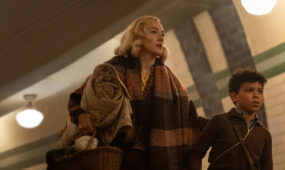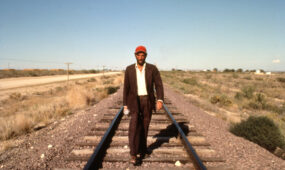These Christmas films deserve some love, actually
Film & TV
So many Christmas films, so little time. Here’s your comprehensive guide to the best and the worst, from classic Hollywood, to hardcore schmaltz and even a few horrors.

The cultural environment in which we watch a film inevitably shapes our response to it. Engaging with the Yuletide ecology by watching Christmas films offers a genuine cinephilic pleasure, be it kitsch, ironic, or sincere.
The following taxonomy is by no means exhaustive – there are far too many Christmas films to mention – but it should present a sufficient overview to keep one’s viewing-December occupied, should one so wish it, with cinematic and televisual fare ranging from the ridiculous to the sublime.
Ho, ho, ho.
Classic Christmas Films
Classical Hollywood cinema offers the most refined, and in many ways the most aesthetically pleasurable, Christmas films.
This is not (necessarily) because they used to make better films in the old days, but simply because old popular cultural products that are still being commercially tapped tend to be (comparatively) pretty good. We don’t read Dickens because people were better writers in the 19th century, but because Dickens was one of the great ones of the period, even if for every Dickens there were hundreds of duds, rightfully now out of print.
Likewise, we don’t watch the 1938 version of Dickens’s A Christmas Carol because films were better in the 1930s, but because this particular film is excellent.
Black and white film, furthermore, evokes a nostalgic ambience that enhances the sentimentality that makes Christmas movies such prolific producers of warm and fuzzy gut-reactions.
Capra’s It’s a Wonderful Life (1946) is the most canonised of the classic Christmas movies, appearing as the Christmas movie of choice in several films and TV specials – including a memorable episode of Beverly Hills 90210 – and it certainly warrants multiple Yuletide viewings.
Gloria Grahame is excellent in a minor role as Violet, and James Stewart as George Bailey does his usual wholesome act perfectly. Capra’s approach, as in most of his films, avoids pure schmaltz, and there is a critical edge in It’s a Wonderful Life’s depiction of the relationship between capitalism and small-town America, challenging the role of finance and commerce as it perverts and invades social life.
There are a few other classic Christmas films which, though less well known, are as good as (or better than) It’s a Wonderful Life – and they are certainly worth including on one’s December list.
It Happened on 5th Avenue (1947) is a hilarious farce involving returned GIs squatting in a New York City mansion. Christmas in Connecticut (1945) is a delightful battle-of-the-sexes film starring the inimitable Barbara Stanwyck and Dennis Morgan.
George Seaton’s Miracle on 34th Street (1947), following the public trial of a man who claims to be Kris Kringle (Edmund Gwenn), is a sweet, gentle film offering a nice counterpoint to the sharper-edged Christmas in Connecticut and It Happened on 5th Avenue.
The Bishop’s Wife (1947), starring Cary Grant and Loretta Young, and Ernst Lubitsch’s The Shop Around the Corner (1940) also deserve mention, as do, for the musically inclined, the Bing Crosby beauties Holiday Inn (1942) and White Christmas (1954), and Vincent Minnelli’s Meet Me in St Louis (1944), starring Judy Garland.
Contemporary Christmas Films
Big-budget, mainstream Hollywood Christmas films usually fall into one of three categories.
The first category includes the snide and sarcastic comedies (often featuring shallowly sentimental endings) that have dominated the genre in its large-scale incarnations since the 1980s.
The essential 1980s Christmas comedy, perhaps, is National Lampoon’s Christmas Vacation (1989) – and no self-respecting Christmas film lover’s December can pass without a visit to the Griswolds. Chevy Chase offers a pitch-perfect comedic performance as the quintessential frustrated American suburban dad, and Christmas Vacation is, arguably, the funniest of the Vacation series.
The other key 1980s comedy for cynics is Scrooged (1988), starring Bill Murray as a dissolute TV executive, and featuring cameos by players as diverse as Robert Mitchum and David Johansen, lead singer of the New York Dolls. Scrooged offers a wry revision of Dickens’ classic, though the cheerful ending does seem forced in the context of this film.
More recently, highlights include A Very Harold & Kumar 3D Christmas (2011) – a return to form for the pair of lovable stoners after the shambolic Escape from Guantanamo Bay (2008) – and Surviving Christmas (2004), a low-key comedy in which a depressed advertising hotshot, played by Ben Affleck, pays an “ordinary” suburban family, led by patriarch James Gandolfini, to host him for the holidays. As Gandolfini and his family increasingly regret the arrangement, Affleck continues to throw more and more money at them in his attempt to fabricate the kind of Norman Rockwellesque Christmas he never had as a child.
Deck the Halls (2006), following Danny DeVito as he tries, to the chagrin of pedantic neighbour Matthew Broderick, to bedeck his house in so many Christmas lights it can be seen from space, and Christmas with the Kranks (2004) are also worth mentioning, as is Ted Demme’s painfully funny The Ref (1994).
Many people swear by Bad Santa (2003) – though (like many of Terry Zwigoff’s films) it leaves a bad taste in the mouth – and probably the only Christmas films worth avoiding altogether are the extremely irritating Four Holidays (2008), starring Reese Witherspoon and Vince Vaughan, and Nora Ephron’s heavy-handed Mixed Nuts (1994).
The second, related, category features Christmas films about the waning of belief in a modern consumerist society, and the subsequent re-invigoration and reproduction of Christmas spirit and jubilation.
The best known in this category are the Home Alone films, but other highlights include Elf (2003), starring Will Ferrell, James Caan and Zooey Deschanel, following the shenanigans of an elf-raised human visiting New York City for the first time, and Jingle All the Way (1996), the best of Schwarzenegger’s comedies, in which he battles, on Christmas eve, to secure a popular toy for his son.
Jingle All the Way contains one of the brilliant scenes of Christmas cinema – a critique of the relationship between the consumer society and the Christmas legend in which zealous parents in search of Turboman, the El Dorado of Christmas toys, attack and maim each other in slow motion, accompanied by Andy Williams’ song “It’s the Most Wonderful Time of the Year”.
It’s also notable for a hilarious performance by the late Phil Hartman in a supporting role as Ted, Schwarzenegger’s cheese-ball neighbour.
Fred Claus (2007), starring Vince Vaughan, Paul Giamatti, Rachel Weisz, Kathy Bates and Kevin Spacey, is one of the best recent Christmas comedies, following the path of Fred Claus, Santa’s brother, as he struggles to emerge from the shadow of his legendary brother. It contains a brilliant spoof of AA-style groups, and is worth watching for this scene alone.
I’ll Be Home for Christmas (1998) likewise contains some hilarious scenes, as college student Jake (Jonathan Taylor Thomas, from Home Improvement) has to make it from the west coast to the east coast of the US by 6pm on Christmas Eve if he is to inherit his father’s Porsche.
Nancy Meyers’ The Holiday (2006) and Love Actually (2003) are both well-made romances set during the Christmas period, although Love Actually has demonstrated superior cultural staying power.
https://www.youtube.com/watch?v=_eCb8w8SRAk
This type of Christmas film often follows a structure akin to A Christmas Carol – including, of course, numerous versions of that story. The Muppet Christmas Carol (1992) is a particularly strong rendition of Dickens.
The third category of big-budget Christmas movies involves films closer to the Christmas story itself, about downtrodden people being given renewed hope over the Christmas period.
These “Christmas Miracle” films include Prancer (1989), One Magic Christmas (1985), and The Christmas Star (1986), all sweetly melancholic films.
The “Christmas Miracle” film is problematic, like so much Hollywood fantasy fare, in that it often offers miraculous solutions to prevalent social problems – even if it acts, in any case, as an eminently satisfying narcotic.
Telemovies
Films about Christmas would be few and far between if it weren’t for the small screen. By far the most prolific of the Christmas film categories is the telemovie.
These films are mostly of the hardcore-schmaltz, Hallmark-channel variety. This kind of super-schmaltz becomes much more palatable when viewed through the green and red lenses of Christmas cheer.
There are far too many Christmas telemovies to mention, but some are worth noting. The excellent Hallmark film, Trading Christmas (2011) is a low-brow version of The Holiday starring solid TV actors Tom Cavanagh (Ed), Gil Bellows (Ally McBeal), and Faith Ford (Hope & Faith).
Two others, unconnected despite the similar titles, are A Mom for Christmas (1990), starring Olivia Newton-John, and A Grandpa for Christmas (2007), starring Hollywood legend Ernest Borgnine in one of his twilight roles.
Perhaps the strangest – and, arguably, most wonderful – Christmas telemovie is the unbeatable Santa With Muscles (1996), which follows Hulk Hogan (the Santa with muscles) as he tries to save an orphanage (!) from an evil property-developer-cum-scientist-cum-megalomaniac. If you are fortunate enough to source a copy of this tongue-in-cheek melodrama, look out for a young Mila Kunis as one of the orphans.
The other wonderful Christmas telemovie is the remake of Christmas in Connecticut (1992), a gentler and, in many ways, funnier, film than the original. Directed by Arnold Schwarzenegger, and starring Dyan Cannon and Kris Kristofferson, this version makes a surprisingly insightful criticism of false representation in televisual culture, while still offering the requisite amount of sentimentality.
https://www.youtube.com/watch?v=iTcn_fkq6NQ
Other telemovies worth having on in the background as you decorate the tree, include The Dog who Saved Christmas (2009), sweet nonsense featuring tele-legend Dean Cain, and The Man who Saved Christmas (2002), a more sober biographical account of AC Gilbert (effectively played by Jason Alexander), a toy manufacturer who refused to cancel Christmas in response to World War I.
Genre films set during Christmas
There are also a considerable number of films that are straightforward genre pieces with Christmas thrown into the mix. These are mostly action and horror films.
There are two obvious examples of 1980s action films set during December that incorporate Christmas into their narratives in a way that is more than incidental.
John McTiernan’s Die Hard (1988), one of the most striking action films of the 1980s, is set during a corporate Christmas party, and John McClane’s subtle and not-so-subtle tirades (and raids) against the corporatisation of America resonate thematically with several of the more explicitly anti-consumerist Christmas films.
Richard Donner’s Lethal Weapon (1987) is likewise set in Los Angeles during Christmas, and perhaps the most memorable scene in the film is the introduction of cop-on-the-edge Martin Riggs (Mel Gibson) as he breaks up a drug deal in a Christmas tree lot.
Something about the Santa myth lends itself to the horror genre, with its combination of magic and maniacs, and there have been several horror films set during Christmas.
Bob Clark’s Black Christmas (1974, poorly remade in 2006), an unnerving “slasher” film avant la lettre, is the best of the Christmas horror films. The recent Rare Exports (2010), from Finland, effectively plays on the supernatural elements of the Santa myth.
Horror aficionados will insist on watching the five films of the Silent Night, Deadly Night (1984) series – crude and unpleasant exercises in mayhem, without the style or suspense of Black Christmas.
Unless one has always imagined Santa as an axe murderer, one should probably avoid these.
Joe Dante’s monster-comedy Gremlins (1984), too, is set during, and reflects on, the Christmas spirit in small-town America, though it wears thin pretty quickly after the dazzling opening 40 minutes or so.
The rest: incidental Christmas films, cartoons, TV specials
There are, in addition to the aforementioned films, several films set partially or entirely during the Christmas period, even as this doesn’t figure at all thematically or in terms of plot.
Richard Kelly’s nasty The Box (2009) comes to mind, as does Joseph Zito’s Reaganite masterpiece of American xenophobia, Invasion USA (1985). Chuck Norris evidently doesn’t get a break when it comes to defending the US from its imagined enemies.
There are several animated Christmas films that are worth watching, including The Nightmare Before Christmas (1993), The Polar Express (2004), and A Christmas Carol (2009) – along with innumerable TV specials and cartoons dedicated to Christmas.
A Charlie Brown Christmas (1965) is particularly good – sweet and sombre at the same time – and some of the old cartoons – Rudolph, the Red-Nosed Reindeer (1964), for example – are Christmas staples. Olive, the Other Reindeer (1999) is a more recent impressive cartoon.
Probably the sharpest of the TV specials is Blackadder’s Christmas Carol (1988), a brilliant, stand alone inversion of Dickens.

Get InReview in your inbox – free each Saturday. Local arts and culture – covered.
Thanks for signing up to the InReview newsletter.
There is one final film that transcends these categories in the complexity of its generic composition – and no spectacular Christmas would be complete without it.
Bob Clark’s A Christmas Story (1983), based on Jean Shepherd’s novel In God We Trust, All Others Pay Cash (1966), is a perfect blend of comedy, coming-of-age story and suburban drama.
It deserves pride of place alongside It’s a Wonderful Life, National Lampoon’s Christmas Vacation and Santa With Muscles at the top of everyone’s must-see Christmas film list.
Ari Mattes is a lecturer in Media Studies at the University of Notre Dame Australia. This article was first published on The Conversation.
Support local arts journalism
Your support will help us continue the important work of InReview in publishing free professional journalism that celebrates, interrogates and amplifies arts and culture in South Australia.
Donate Here







Comments
Show comments Hide comments